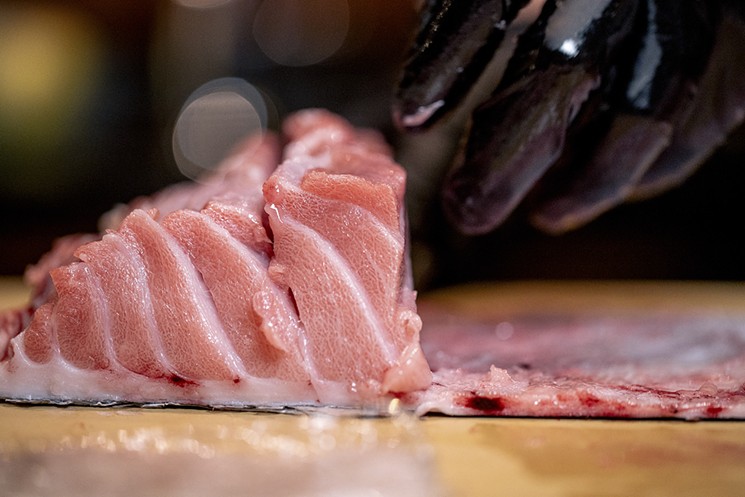On a recent Tuesday, Tadashi Shiraishi, a medium-size man with dark-framed glasses and spiked black hair, scurries into the Taco Stand in Wynwood. He passes a young woman in a white apron flattening tortilla dough, and a tall lanky fellow stuffing French fries into burritos. He stops in front of a bare copper wall at the restaurant's rear, looks to his right, and presses a few buttons on a silver keypad. The wall magically becomes a door, sliding open to reveal a covert room.
This is Hiden, a mysterious omakase restaurant disguised in plain sight. A $130 reservation will get you 16 courses of fish flown overnight from Japan. It's the sister restaurant of the funky Taco Stand, a popular Mexican mini-chain from California that opened in late February.
"We make true Japanese cuisine. I refuse to cross that Western border."
tweet this
But the two are conceptually worlds apart. At Hiden, executive chef Shiraishi prepares the type of Japanese food he grew up with. There is no truffle oil, cream cheese, or spicy tuna rolls. The disciplined 32-year-old steams rice, sears tuna, and grills beef twice per night, six days a week in a quiet, unassuming, and impressively secret space.
"We make true Japanese cuisine," Shiraishi says with a slight accent. "I refuse to cross that Western border."
Shiraishi was born and raised in São Paulo, Brazil, in a traditional and affluent Japanese family. As a young boy, he watched his grandmother wake at 4 a.m. Sundays to cook. He later joined her and learned to simmer vegetables, braise pork belly, and slow-cook fish.
In high school, Shiraishi skipped afternoon classes to flip burgers at a nearby diner. "Anything to get me inside a kitchen," he says.
When it came time for college, he was determined to become a chef. His parents, both in the auto industry, refused to pay for culinary school. So he searched for a job in a local kitchen.
"They could afford it but wouldn't put a dime into it," he remembers. "So I basically had to say to my dad, 'Fuck you. I really want to do this.' I didn't care about taking over the family business. I wanted to cook."
Over the past decade, Shiraishi has helmed kitchens around the world, in Tokyo, Greece, and Switzerland. He's worked alongside the venerable chef Nobu Matsuhisa and has spent time at two Michelin-starred restaurants in Brazil: Kinoshita and Huto. By the age of 29, he had opened a classic Japanese restaurant in Brazil, which closed in mid-2017.
"Japanese food culture in Brazil exploded in a specific direction," he says. "All of a sudden, you have California rolls. That's not the Japanese food I wanted to make, so it all backfired."
Around the same time, Shiraishi was approached by Showa Hospitality, owned by restaurateurs Julian Hakim and Aram Baloyan, and Edo Lopez, who also runs Edo Kobayashi, a prominent Mexico City hospitality group known for Japanese restaurants. Hakim and Baloyan, who also own the Taco Stand, first partnered with Lopez to open a sushi restaurant in San Diego. Before Hiden, Hakim and Baloyan considered a secret mezcal bar in the back of the Taco Stand in Wynwood. But Lopez suggested the omakase concept.
"It was just a funky idea," Hakim says. "It's only been a month, and reservations are booked three weeks in advance. I'm even surprised at how quick it was to become this successful."
Unlike its Mexican counterpart, Hiden has no neon signage or artful graffiti. Outfitted with sleek wood furnishings and lit with dim recess lighting, the 450-square-foot space includes cement walls, black tiled floors, and sparkling fine glassware. There are no windows or adjacent rooms. The design mirrors a traditional Japanese speakeasy, where the focus is strictly on the food.
Twice a week, Shiraishi receives fish from Japan. Among the deliveries is firefly squid, an electric-blue creature that lights the ocean in hues of sapphire. The chef also visits local markets to pick up produce almost daily. There are no menus. Instead, Shiraishi determines what he will serve just hours before dinnertime.
Inside a small metal freezer beneath the sushi bar, he uses rice paper to age certain types of fatty fish such as tuna or yellowtail. As with beef, the fish becomes tenderized, which helps enhance the flavor. Otherwise, no other ingredients are frozen.
"It's about what I have in my hands," he says. "Sometimes I only have enough for eight people. Other times, I take the same item and prepare it in a very different way. It pushes me beyond the obvious."
Shiraishi works in the tiny open kitchen while eight eager diners crowd around him. His wife Caroline tends to the front of house. The two-hour experience sees Shiraishi, in a blue chef's jacket, standing at the center of the bar, ready to perform an intricate culinary dance in which he and his assistant chef prepare, cook, and serve 128 plates per seating.
"I'm not a very fun guy," Shiraishi says with a smirk. "I'm serious and strict. I live for this."
Whiffs of freshly steamed rice and just-sliced fish greet diners upon entry. Once they are seated, the meal begins with a glass of chilled champagne and one oyster. Depending upon how Shiraishi feels, the oyster may be baked, deep-fried, or served fresh. From there, he begins a journey of two cold appetizers, typically a sashimi selection or tuna tasting, and a warm soup. Then come eight to ten sushi items, cured or seared and served on a fancy-looking plate, followed by a hot entrée such as Wagyu steak. He caps off the meal with a light dessert. Each item is prepared on the spot.
Since its debut March 6, Hiden has been filled to capacity. Despite the absence of advertising, the restaurant is nearly booked solid through April. "When a restaurant opens, there's always a buzz," Shiraishi says, "but we've already seen customers return two or three times. I don't want to get too excited, but I think this is more than momentum."
Reservations can be made only through Tock, an upscale version of OpenTable. A few hours before arrival, diners receive entry codes, directions, and instructions that the restaurant is "hidden." Then, at 7 and 10 p.m., well-dressed couples can be seen walking through the Taco Stand, which is filled with mariachi music and the aroma of fried tortillas, and proceeding to the secret door. They often appear confused. That's the fun of it, according to Shiraishi.
"It was always about working hard to become good enough to be in the U.S.," he says. "It was a childhood dream to move here. Kind of corny. But corny is nice."













